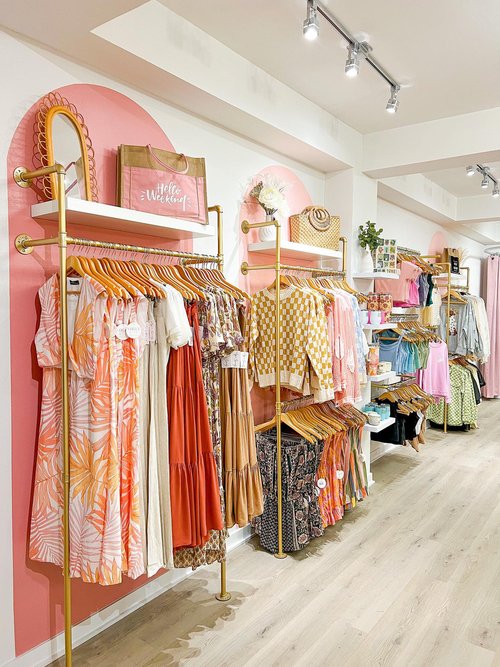Unveiling the Tricks Behind Economical Boutique Fashion
Unveiling the Tricks Behind Economical Boutique Fashion
Blog Article
Exploring the Development and Influence of Garments on Modern Style Trends
The development of garments has considerably influenced modern fashion fads, merging historic criteria with advanced innovations. Renowned figures like Coco Chanel and Yves Saint Laurent transformed the style sector by introducing ideas that focus on comfort and accessibility, which continue to resonate today.
Historical Style Influencers
In the tapestry of fashion history, particular numbers have actually left an enduring mark, shaping the patterns and styles that specify entire eras. Coco Chanel, an innovative developer, redefined ladies's style by introducing comfortable, elegant clothes that left from restrictive corsets. Her legendary Chanel fit and little black gown have ended up being classic staples in closets worldwide. Similarly, Christian Dior's post-war "Makeover" in 1947, with its party of feminineness through full skirts and cinched waistlines, noted a go back to luxury and has actually remained to affect designers.
Elsa Schiaparelli is an additional essential figure, renowned for her avant-garde layouts that integrated surrealist art, collaborating with Salvador Dalí to create whimsical pieces that tested standard looks. Her ingenious use of shade and vibrant patterns reverberates in contemporary style. Yves Saint Laurent, at the same time, equalized high style with prêt-à-porter collections, bringing runway designs to the masses and establishing a criterion for contemporary ready-to-wear lines.
These dreamers, to name a few, not just changed style in their times yet likewise established withstanding fads that reverberate in today's style market, offering a structure upon which modern-day developers proceed to innovate and develop. Their legacies highlight the significance of creative thinking and daring in style's ever-evolving narrative.
Technical Innovations in vogue
Among the dynamic landscape of the fashion market, technical innovations stand at the leading edge of technology, improving how developers develop and consumers involve with style. The integration of 3D printing has transformed design procedures, making it possible for developers to try out intricate frameworks and sustainable materials that were formerly impossible. This innovation promotes rapid prototyping, lowering waste and accelerating manufacturing times.

Smart fabrics, installing innovation right into textiles, are likewise changing the sector. Developments like self-cleaning and temperature-regulating materials use improved performance and comfort. Wearable technology, integrating attributes like health and fitness monitoring and interaction, adds a brand-new dimension to style, merging aesthetics with practicality.
Social Changes and Style
As technical advancements remain to reshape the apparel industry, cultural changes are similarly influential, redefining style and consumer choices. In the last few years, the rise of social networks systems has accelerated the circulation of global fashion fads, permitting diverse cultural impacts to converge and exist together. This electronic interconnectivity has actually facilitated the fast exchange of ideas, bring about a more inclusive and eclectic analysis of design site link that shows the multifaceted nature of modern culture.
Cultural awareness and gratitude have actually motivated developers to attract motivation from a broader range of historical and ethnic contexts, incorporating traditional concepts with modern appearances. This fusion has resulted in style that resonates with a larger audience, advertising a sense of identity and belonging throughout different demographics. Additionally, the boosting demand for personalization has actually driven brands to provide personalized choices, allowing consumers to share uniqueness while showing their cultural heritage.
In addition, changing societal worths have actually impacted style, with inclusivity and variety coming to be central styles. The industry has started to accept models and influencers of different physique, ethnic backgrounds, and sex identifications, difficult traditional elegance criteria. This improvement highlights the power of cultural shifts in shaping the future of style, as style comes to be a much more genuine expression of collective and personal identification.
Sustainability and Modern Design
While the style market continues to advance, the essential for sustainability has ended up being increasingly immediate, influencing contemporary style techniques. The surge of slow style, which stresses top quality over amount, motivates consumers to spend in ageless items instead than transient patterns.
Furthermore, modern-day style is identified by its development in decreasing waste and promoting circularity. Techniques such as zero-waste pattern cutting and 3D knitting are obtaining traction, allowing developers to develop garments with marginal fabric waste. In addition, brand names are adopting clear supply chains, guaranteeing liability and cultivating consumer count on. This technique not only mitigates ecological influence but likewise enhances the social responsibility of style houses.

Future Trends in Style

Sustainability will certainly remain to be a driving force in shaping future fashion trends. The sector is increasingly embracing environmentally friendly materials and ethical news manufacturing approaches, replying to an expanding customer need for responsible practices. Developments such as bio-fabricated products and closed-loop recycling check this systems are established to redefine exactly how clothes is created and taken in, minimizing ecological influence while maintaining design and high quality.
Cultural changes, consisting of the increase of inclusivity and variety, will additionally play a critical duty. As society comes to be much more familiar with social problems, style is anticipated to end up being a system for expression and adjustment. Designers will likely concentrate on creating collections that reflect a more comprehensive series of identities and experiences, championing depiction and accessibility.
Final Thought
The advancement of clothing substantially impacts modern fashion fads, where historic influences merge with contemporary styles. Secret numbers like Coco Chanel and Yves Saint Laurent have redefined design, while technical technologies such as 3D printing and smart textiles broaden imaginative opportunities. Social shifts towards inclusivity and sustainability oblige brands to embrace moral techniques and embrace diversity. This continuous development emphasizes style's duty as a mirror to social worths and technical innovation, recommending a future abundant with technology and inclusivity.
The development of garments has considerably influenced modern-day style patterns, merging historical criteria with innovative advancements.In the middle of the dynamic landscape of the style sector, technological advancements stand at the center of technology, improving how designers develop and consumers engage with style.While the fashion industry proceeds to develop, the necessary for sustainability has ended up being significantly urgent, affecting contemporary design techniques. As sustainability ends up being embedded in modern-day design, it leads the method for a more accountable and conscious style market.
The advancement of garments significantly influences modern style trends, where historic influences combine with contemporary styles.
Report this page